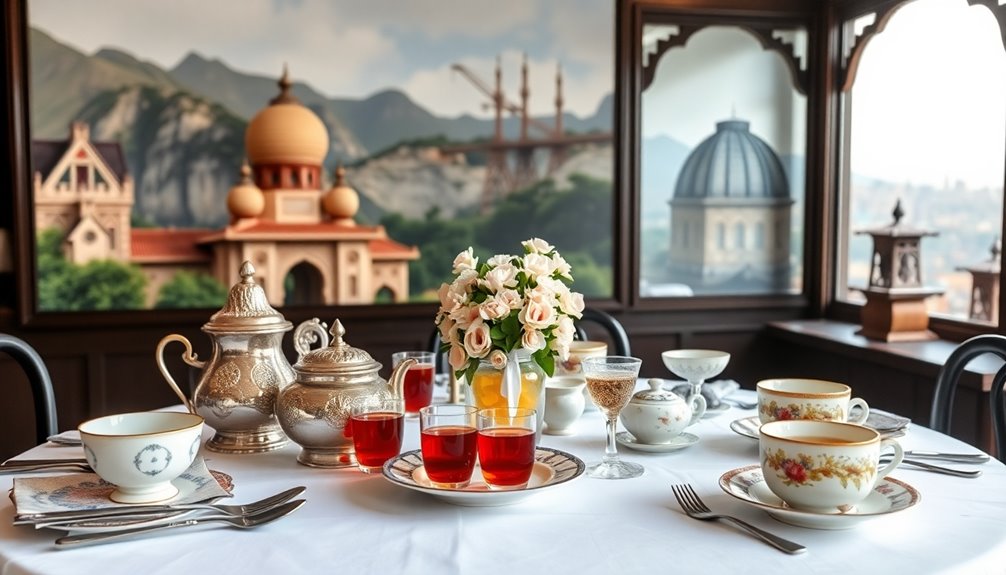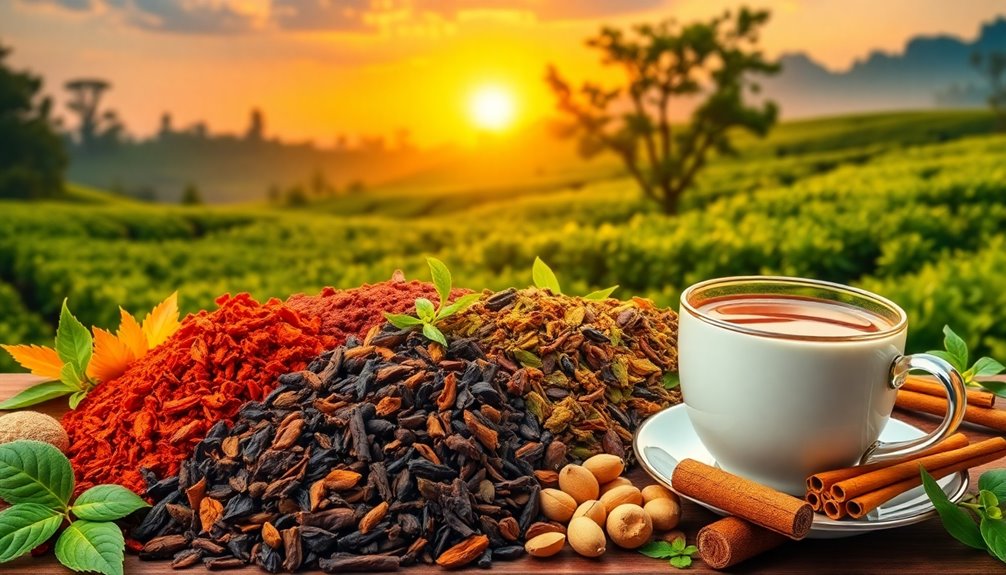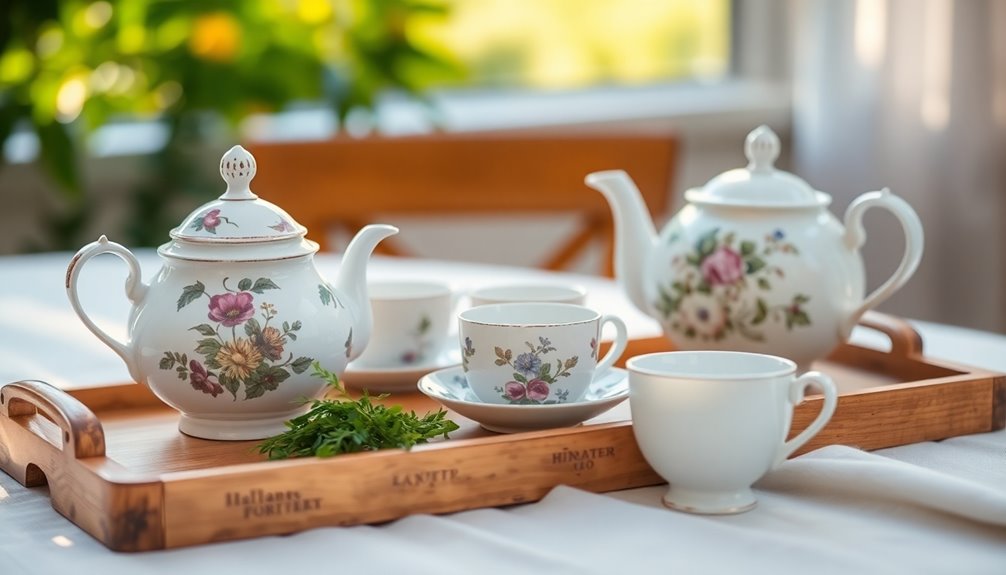Tea etiquette varies greatly around the world, with each culture holding unique customs that reflect their values. In Japan, the precision of the tea ceremony promotes mindfulness, while in Kenya, sharing a cup strengthens community bonds. Turkish tea is served strong and sweet in small glasses, emphasizing hospitality. Argentine mate is enjoyed through a communal ritual, showcasing camaraderie. Each variation highlights respect and connection in social settings. Understanding these differences can deepen your appreciation of tea culture globally, and you'll discover even more fascinating practices that define tea traditions in various regions.
Key Takeaways
- Japanese tea ceremonies prioritize mindfulness and respect, emphasizing precise gestures and aesthetics in their rituals.
- Turkish tea is traditionally served strong and sweetened in small glasses, symbolizing warmth and hospitality.
- In Argentina, mate is shared communally without stirring, highlighting respect and camaraderie among participants.
- Kenyan tea practices involve sharing and refills, reinforcing community bonds and making refusal impolite.
- Cultural appropriation of tea customs risks diluting their significance, emphasizing the need for respect and understanding of origins.
Introduction
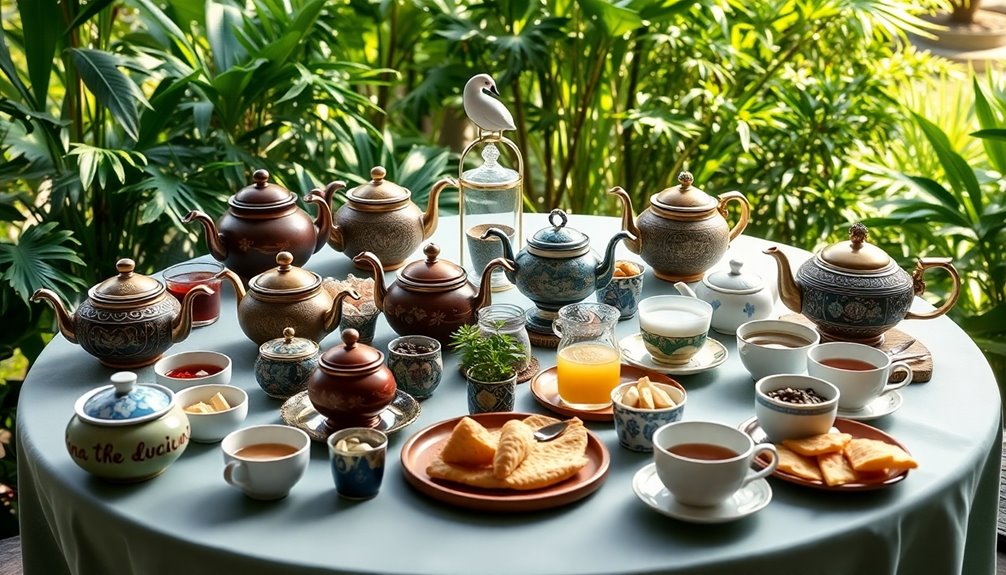
Tea is more than just a beverage; it's a cultural ritual that varies widely around the globe. When you dive into the world of tea, you'll discover rich traditions and unique tea etiquette that reflect local customs and values surrounding hospitality.
For instance, in Japan, the tea ceremony highlights respect and aesthetics; you should hold your cup with two hands and feel free to slurp the tea as a way to appreciate its flavor.
In contrast, if you find yourself in Turkey, you'll notice black tea served in small, curved glasses, typically accompanied by sugar but no milk—an important cultural custom.
When you visit India, expect to politely decline the first offer of chai, as accepting it upon insistence shows respect for your host's hospitality.
Meanwhile, in Russia, tea is often part of social gatherings, and serving it without snacks can be considered rude, emphasizing the importance of pairing food and drink.
Each of these examples illustrates how drinking tea transcends mere consumption; it's an experience shaped by a tapestry of traditions and cultural nuances.
Global Tea-Serving Customs

Experiencing tea around the world means encountering a variety of serving customs that reflect each culture's values and social norms.
For instance, in Hong Kong, you won't pour your own tea—your host will serve you, and tapping your fingers on the table shows gratitude. In Turkey, tea is served in small, curved glasses, brewed strong and sweetened, symbolizing hospitality.
Meanwhile, Argentine tea drinkers cherish mate, passing the gourd around without stirring it, as accepting the mate signifies respect within the group. Traditional Japanese tea ceremonies highlight the importance of mindfulness; you'll hold your cup with both hands and appreciate the tea quietly, with slurping allowed to enhance the experience.
In Kenya, sharing tea is essential for building community, and guests are expected to accept offered cups, as refusal can be seen as impolite.
You'll also find various tea traditions from around the globe, including the love for black tea in India, where it's often brewed with spices and served in bustling street stalls.
Each of these customs showcases the unique way different cultures value connection and hospitality through tea.
Cultural Tea Serving Variations

Many cultures have unique ways of serving tea that reflect their values and traditions. In Turkey, for example, black tea is served in small, curved glasses, often sweetened with sugar to enhance the strong flavor. Milk or cream is typically avoided, showcasing a preference for traditional, unadulterated tea.
Meanwhile, in Japan, the tea ceremony (Chanoyu) emphasizes aesthetics and respect. Here, preparing and serving matcha involves precise gestures that highlight harmony and mindfulness.
In Morocco, Moroccan Mint tea is heavily sweetened and poured from a height to create a frothy top, symbolizing hospitality and social connection. This ritualized process is central to their tea drinking culture.
Argentine mate rituals take a different approach—participants pass the mate gourd around, sharing without stirring the leaves, which promotes camaraderie and respect.
In Kenya, tea is often accompanied by local snacks, and it's customary to accept offered cups, with refills expected if the cup is less than half full.
These cultural tea serving variations show how tea is more than just a beverage; it's a reflection of community, tradition, and connection across the globe. Additionally, the calming effects of certain essential oils, such as lavender oil, can enhance the overall experience of tea drinking by promoting relaxation and mindfulness.
Ceremonial Tea Serving Rituals
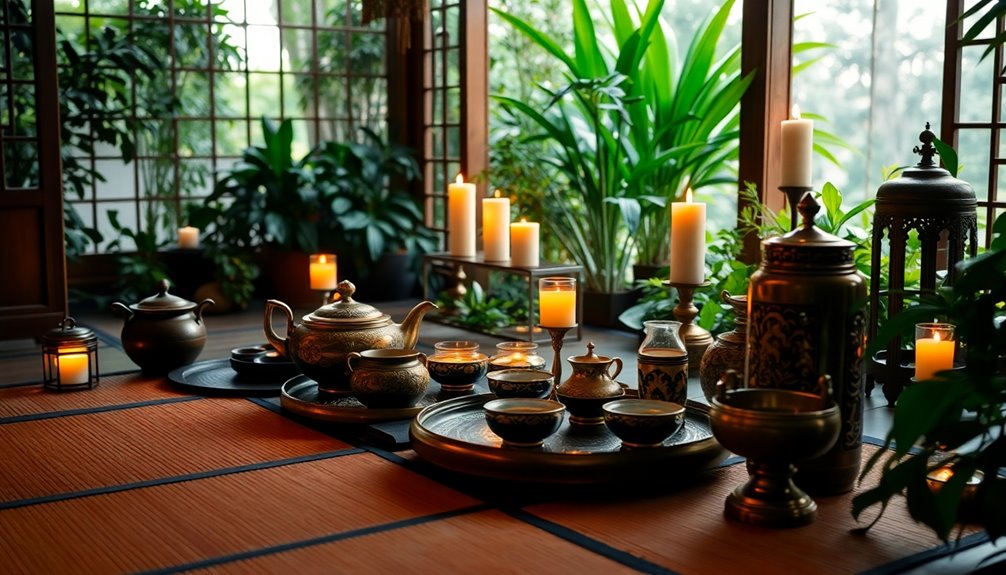
Focusing on the art of ceremonial tea serving reveals a rich tapestry of rituals that vary widely across cultures.
In Japan, the tea ceremony, or Chanoyu, invites you to experience harmony and mindfulness as you prepare and serve matcha in a serene setting. Each movement is deliberate, promoting tranquility and reflection.
In contrast, the Chinese Gongfu tea ceremony showcases skillful brewing with structured steps, allowing you to appreciate the tea's nuances while fostering a deep connection to the beverage.
Meanwhile, in Morocco, the act of pouring tea from a height creates a frothy top, symbolizing hospitality and enhancing your overall tea experience.
When you partake in Indian Masala Chai customs, you'll find that refusing the first offer is polite; accepting it later signifies respect and reinforces hospitality.
In Turkey, tea served in small, curved glasses promotes sharing in social settings, strengthening community connection among friends.
Each of these rituals not only enriches the tea experience but also cultivates mindfulness, reminding us of the importance of connection and respect in every cup.
Cultural Appropriation of Tea Practices
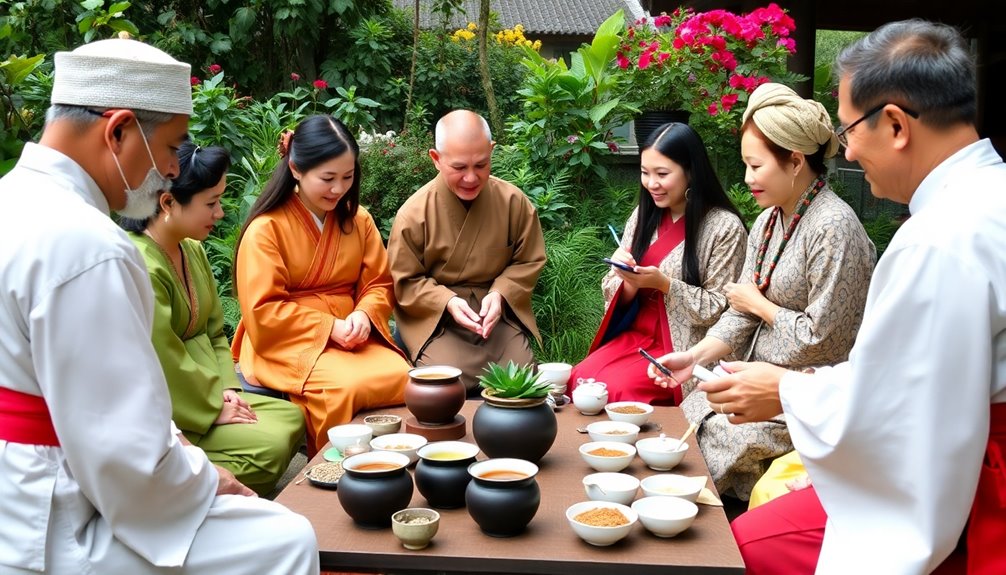
While exploring the rich rituals surrounding tea, it's important to consider how these traditions can be misrepresented through cultural appropriation. When you adopt elements of traditional tea practices, like the Japanese tea culture's Chado, without understanding their historical and cultural significance, you risk diluting their essence. This practice emphasizes spirituality and mindfulness, which are often overlooked in adaptations.
Similarly, Western iterations such as afternoon tea can strip away the depth and nuances of British tea customs, turning a revered tradition into just another social event. In India, the commercialization of chai leads to variations that disregard essential preparation methods and the communal significance that defines its identity.
To truly engage with tea practices, it's crucial to respect and honor their origins. Recognizing the values, rituals, and community significance tied to these traditions fosters a deeper appreciation.
Instead of appropriating, consider promoting cultural exchange that enriches your understanding. By doing so, you contribute to a more respectful dialogue around tea, ensuring that the art of making and sharing tea remains a celebration of its rich heritage rather than a mere trend.
Practical Applications
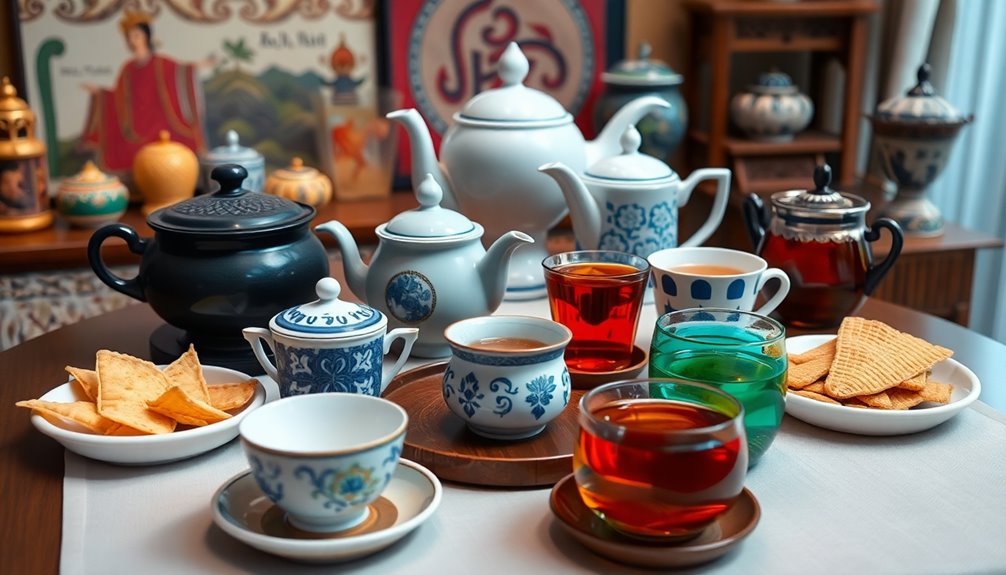
Navigating tea etiquette across cultures can enhance your experience and show respect for local traditions. When you find yourself in a Japanese setting, remember to bow slightly when receiving tea; this gesture embodies respect.
Participate in the tea ceremony by holding your cup with both hands, appreciating the tea's cultural significance and the mindfulness it encourages.
In Turkish culture, you'll encounter black tea served in small, curved glasses. Feel free to add sugar, but avoid milk to maintain the traditional taste.
If you're in China, accepting tea is crucial; refusing it could be seen as disrespectful. Always offer and accept tea with both hands to honor the customs.
In Kenya, tea is a communal experience. Even if you only sip from your cup, accepting the offer fosters community and connection.
Each culture features various types of tea and unique traditions that enrich your understanding and appreciation of this beloved beverage.
By embracing these practices, you'll not only enjoy your tea but also strengthen your social interactions and deepen your cultural knowledge.
Conclusion
In exploring tea etiquette around the world, you've discovered diverse customs that reflect each culture's values and traditions. From Japan's meticulous tea ceremonies to the casual afternoon tea in England, each practice adds richness to the global tapestry of tea. By understanding and respecting these variations, you can appreciate the deeper meanings behind each cup. So, next time you enjoy tea, remember the unique stories and customs that shape this beloved beverage across the globe.

